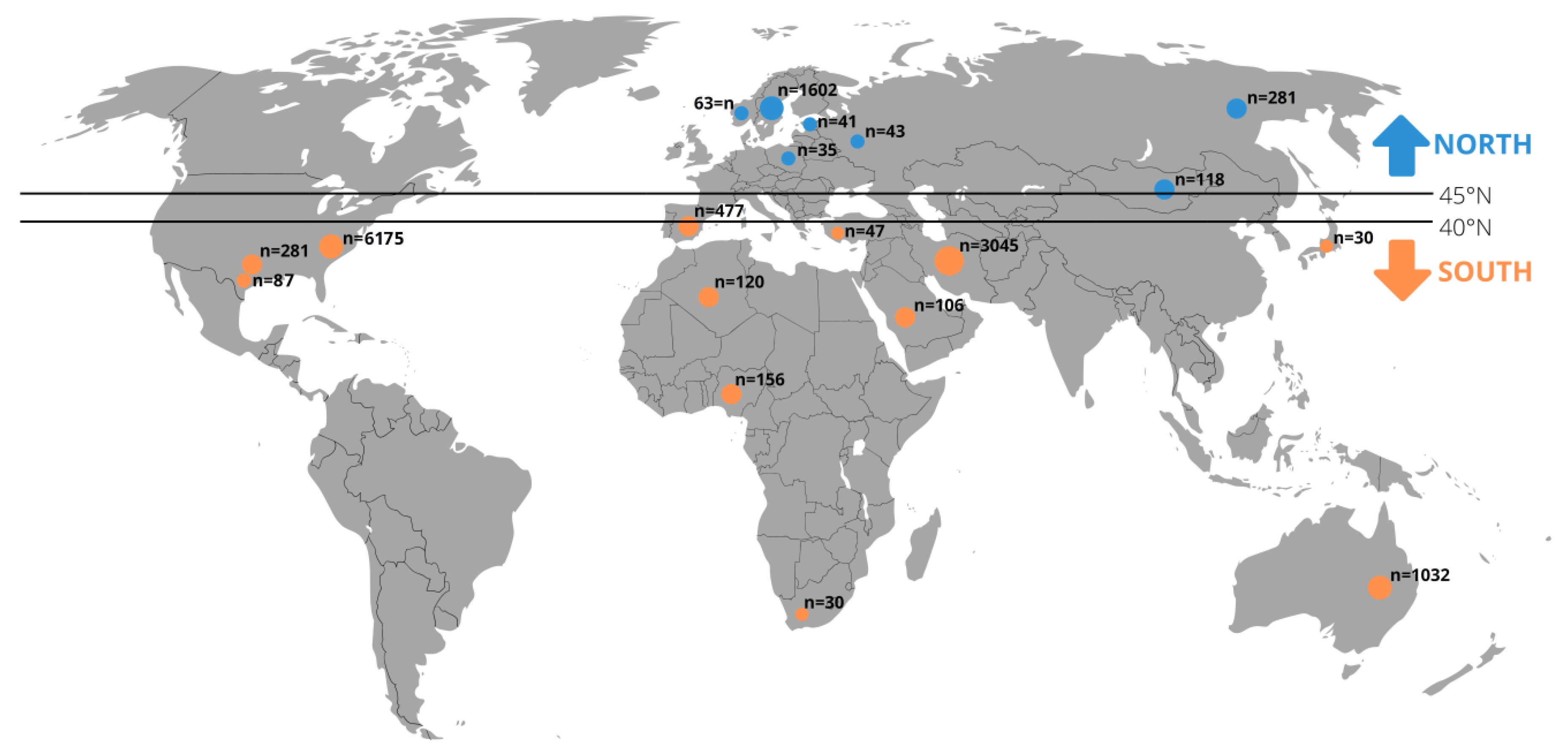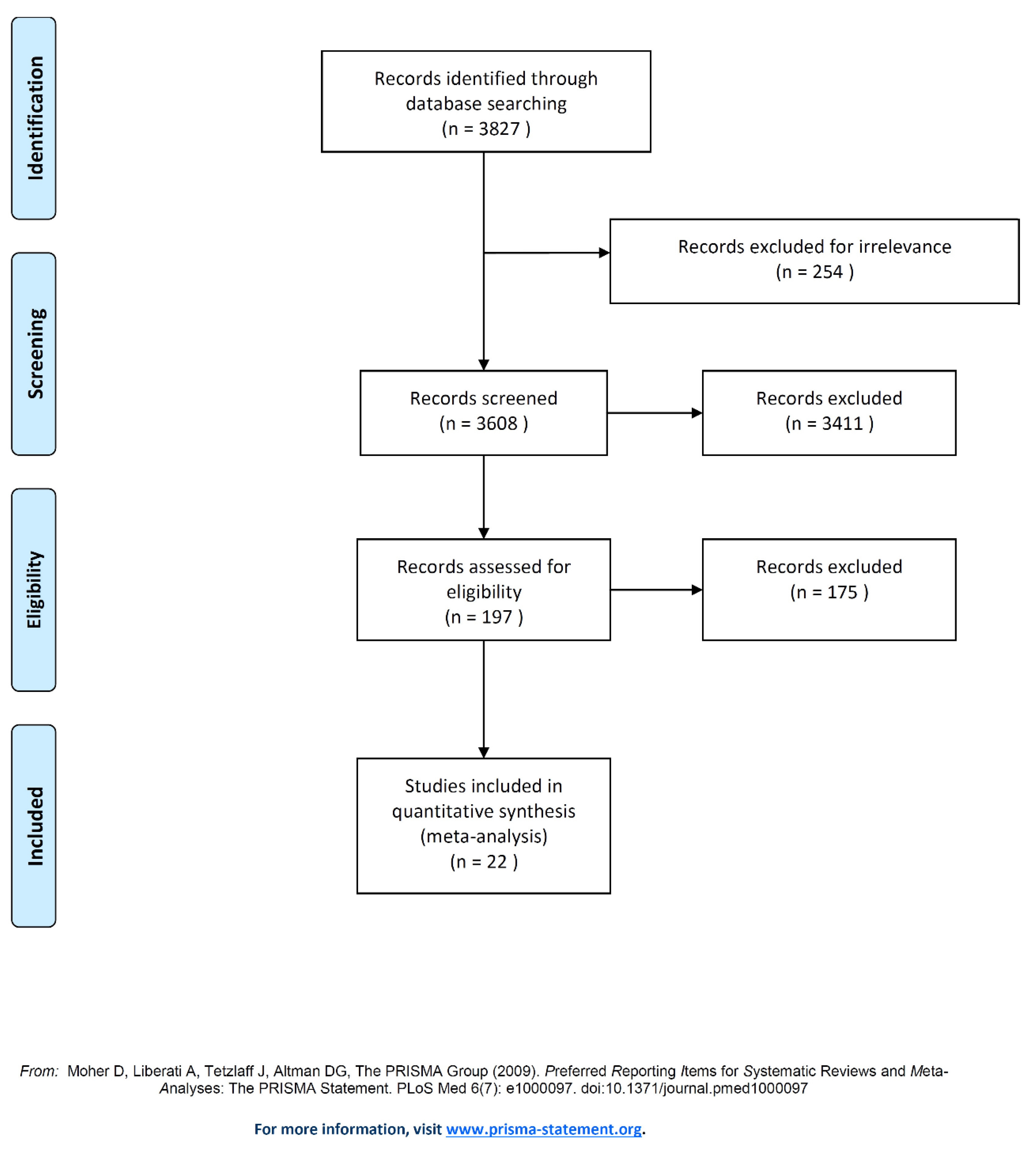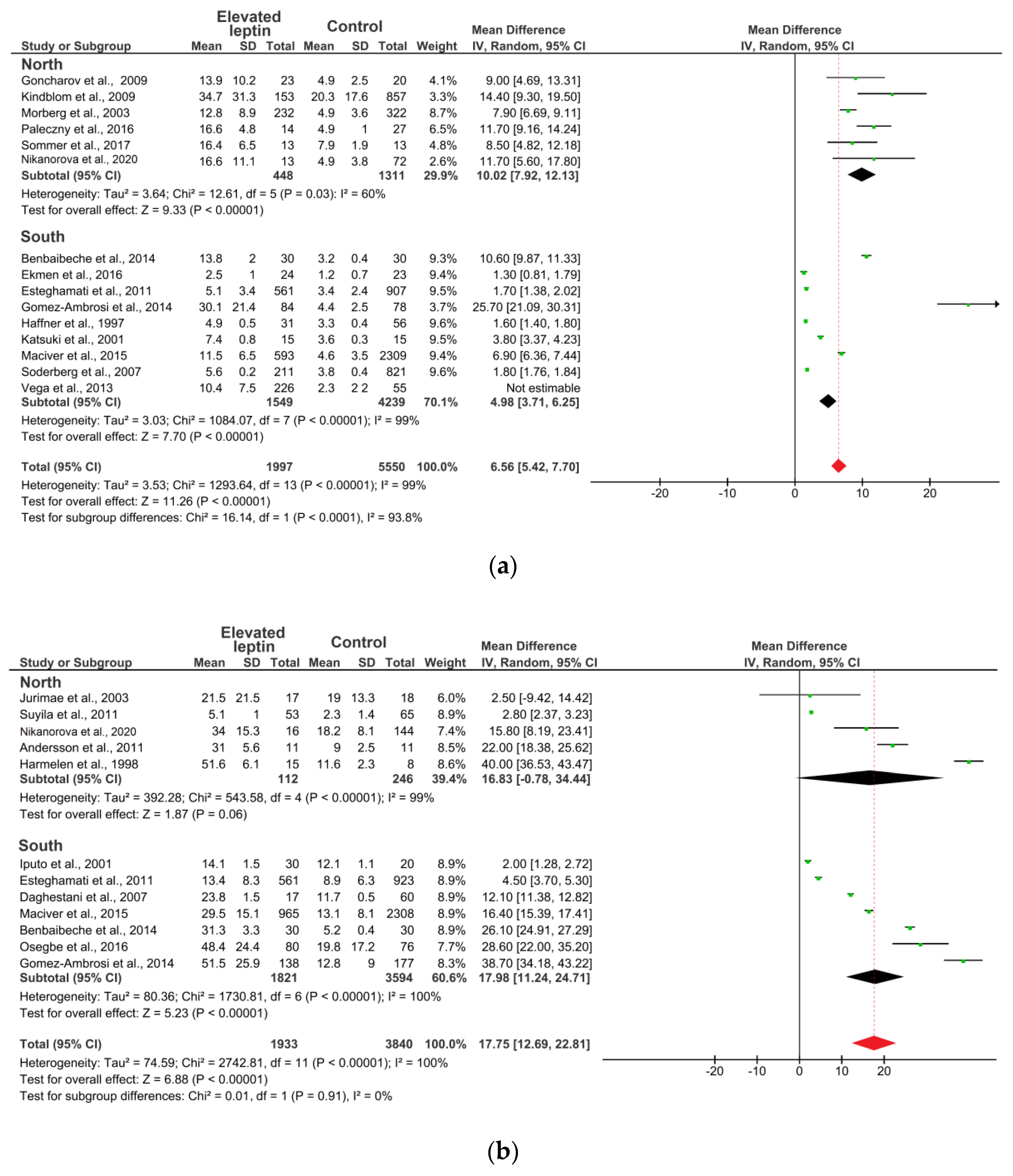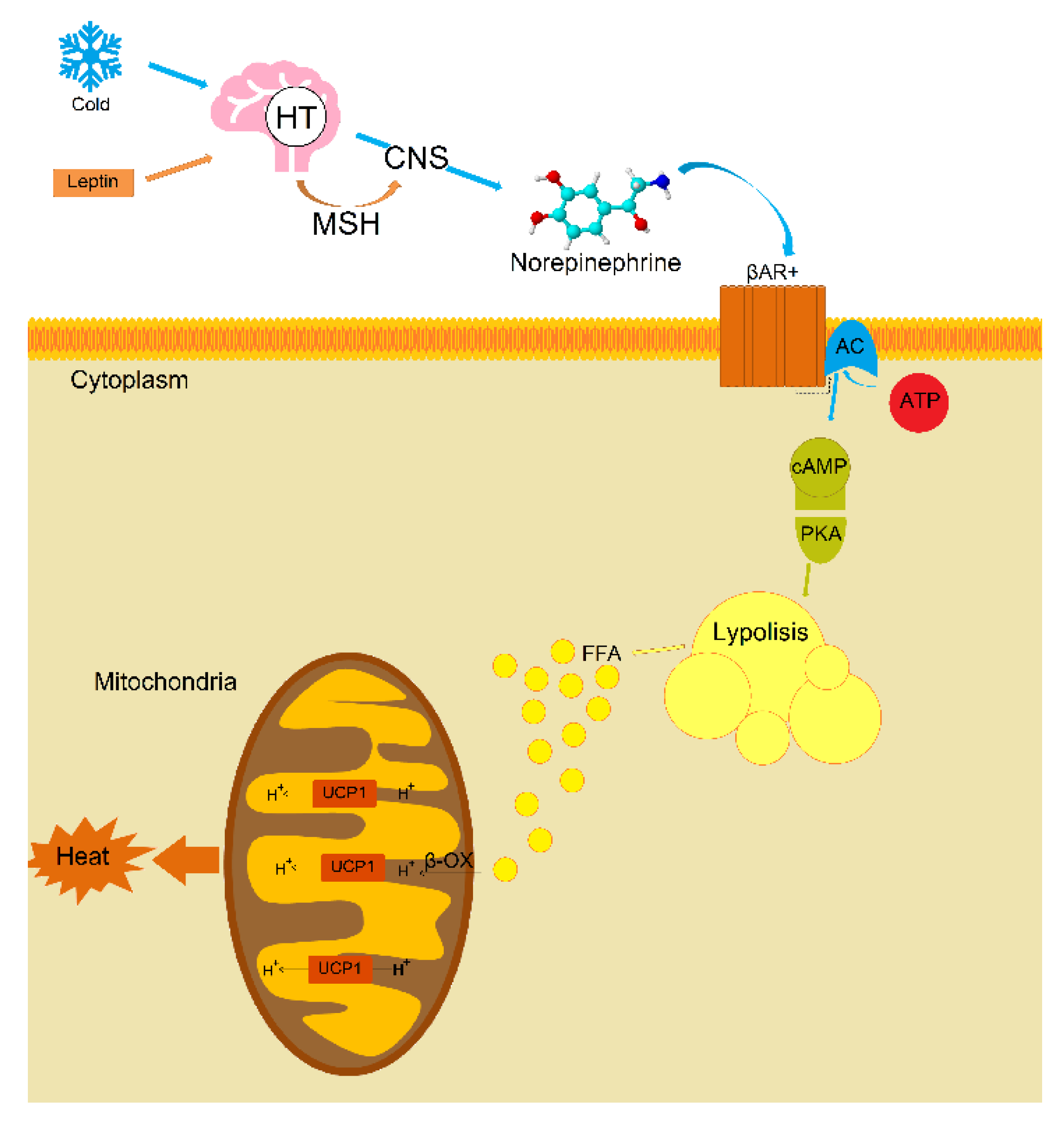The Role of Leptin Levels in Adaptation to Cold Climates
Abstract
1. Introduction
2. Materials and Methods
2.1. Search Strategy
2.2. Inclusion and Exclusion Criteria
2.3. Data Extraction
2.4. Quality Control
2.5. Data Analysis
2.6. Climatic Environment
2.7. Limitations of Meta-Analysis
2.8. Ethics Statement
3. Results
3.1. Literature search and Eligible Studies
3.2. Characteristics of the Articles
3.3. The Leptin Levels Depending on Climatic Conditions
4. Discussion
5. Conclusions
Author Contributions
Funding
Acknowledgments
Conflicts of Interest
References
- Shephard, R.J. Health Consequences of ‘Modernization’: Evidence from Circumpolar Peoples, 1st ed.; Cambridge University Press: Cambridge, UK, 2008. [Google Scholar]
- Pääkkönen, T.; Leppäluoto, J. Cold Exposure and Hormonal Secretion: A Review. Int. J. Circumpolar Health 2002, 61, 265–276. [Google Scholar] [CrossRef]
- Bjerregaard, P.; Dewailly, E.; Young, T.K.; Blanchet, C.; Hegele, R.A.; Ebbesson, S.E.O.; Risica, P.M.; Mulvad, G. Blood Pressure among the Inuit (Eskimo) Populations in the Arctic. Scand. J. Public Health 2003, 31, 92–99. [Google Scholar] [CrossRef] [PubMed]
- Nedergaard, J.; Bengtsson, T.; Cannon, B. Unexpected Evidence for Active Brown Adipose Tissue in Adult Humans. Am. J. Physiol. Endocrinol. Metab. 2007, 293, 444–452. [Google Scholar] [CrossRef] [PubMed]
- Cypess, A.M.; Lehman, S.; Williams, G.; Tal, I.; Rodman, D.; Goldfine, A.B.; Kuo, F.C.; Palmer, E.L.; Tseng, Y.-H.; Doria, A.; et al. Identification and Importance of Brown Adipose Tissue in Adult Humans. N. Engl. J. Med. 2009, 360, 1509–1517. [Google Scholar] [CrossRef] [PubMed]
- van Marken Lichtenbelt, W.D.; Vanhommerig, J.W.; Smulders, N.M.; Drossaerts, J.M.A.F.L.; Kemerink, G.J.; Bouvy, N.D.; Schrauwen, P.; Teule, G.J.J. Cold-Activated Brown Adipose Tissue in Healthy Men. N. Engl. J. Med. 2009, 360, 1500–1508. [Google Scholar] [CrossRef] [PubMed]
- Virtanen, K.A.; Lidell, M.E.; Orava, J.; Heglind, M.; Westergren, R.; Niemi, T.; Taittonen, M.; Laine, J.; Savisto, N.-J.; Enerbäck, S.; et al. Functional Brown Adipose Tissue in Healthy Adults. N. Engl. J. Med. 2009, 360, 1518–1525. [Google Scholar] [CrossRef]
- Mirbolooki, M.R.; Constantinescu, C.C.; Pan, M.-L.; Mukherjee, J. Quantitative Assessment of Brown Adipose Tissue Metabolic Activity and Volume Using 18F-FDG PET/CT and Β3-Adrenergic Receptor Activation. EJNMMI Res. 2011, 1, 30. [Google Scholar] [CrossRef] [PubMed]
- Orava, J.; Nuutila, P.; Lidell, M.E.; Oikonen, V.; Noponen, T.; Viljanen, T.; Scheinin, M.; Taittonen, M.; Niemi, T.; Enerbäck, S.; et al. Different Metabolic Responses of Human Brown Adipose Tissue to Activation by Cold and Insulin. Cell Metab. 2011, 14, 272–279. [Google Scholar] [CrossRef]
- Tomskiy, M.I.; Chinti, S.; Tikhonov, D.G.; Loskutova, K.S.; Isakov, E.A. Brown Adipose Tissue and Extremely Cold Climate. Yakut Med. J. 2015, 49, 102–107. [Google Scholar]
- Cannon, B.; Nedergaard, J. Brown Adipose Tissue: Function and Physiological Significance. Physiol. Rev. 2004, 84, 277–359. [Google Scholar] [CrossRef]
- Efremova, A.; Senzacqua, M.; Venema, W.; Isakov, E.; Di Vincenzo, A.; Zingaretti, M.C.; Protasoni, M.; Thomski, M.; Giordano, A.; Cinti, S. A Large Proportion of Mediastinal and Perirenal Visceral Fat of Siberian Adult People Is Formed by UCP1 Immunoreactive Multilocular and Paucilocular Adipocytes. J. Physiol. Biochem. 2019. [Google Scholar] [CrossRef] [PubMed]
- Kajimura, S.; Seale, P.; Kubota, K.; Lunsford, E.; Frangioni, J.V.; Gygi, S.P.; Spiegelman, B.M. Initiation of Myoblast/Brown Fat Switch through a PRDM16-C/EBP-β Transcriptional Complex. Nature 2009, 460, 1154–1158. [Google Scholar] [CrossRef] [PubMed]
- Petrovic, N.; Walden, T.B.; Shabalina, I.G.; Timmons, J.A.; Cannon, B.; Nedergaard, J. Chronic Peroxisome Proliferator-Activated Receptor γ (PPARγ) Activation of Epididymally Derived White Adipocyte Cultures Reveals a Population of Thermogenically Competent, UCP1-Containing Adipocytes Molecularly Distinct from Classic Brown Adipocytes. J. Biol. Chem. 2010, 285, 7153–7164. [Google Scholar] [CrossRef] [PubMed]
- Wang, X.; Wahl, R. Responses of the Insulin Signaling Pathways in the Brown Adipose Tissue of Rats Following Cold Exposure. PLoS ONE 2014, 9, e99772. [Google Scholar] [CrossRef]
- Cypess, A.M.; Haft, C.R.; Laughlin, M.R.; Hu, H.H. Brown Fat in Humans: Consensus Points and Experimental Guidelines. Cell Metab. 2014, 20, 408–415. [Google Scholar] [CrossRef]
- Bonet, M.L.; Oliver, P.; Palou, A. Pharmacological and Nutritional Agents Promoting Browning of White Adipose Tissue. Biochim. Biophys. Acta (BBA) Mol. Cell Biol. Lipids. 2013, 1831, 969–985. [Google Scholar] [CrossRef]
- Suárez-Zamorano, N.; Fabbiano, S.; Chevalier, C.; Stojanović, O.; Colin, D.J.; Stevanović, A.; Veyrat-Durebex, C.; Tarallo, V.; Rigo, D.; Germain, S.; et al. Microbiota Depletion Promotes Browning of White Adipose Tissue and Reduces Obesity. Nat. Med. 2015, 21, 1497–1501. [Google Scholar] [CrossRef]
- Mu, Q.; Fang, X.; Li, X.; Zhao, D.; Mo, F.; Jiang, G.; Yu, N.; Zhang, Y.; Guo, Y.; Fu, M.; et al. Ginsenoside Rb1 Promotes Browning through Regulation of PPARγ in 3T3-L1 Adipocytes. Biochem. Biophys. Res. Commun. 2015, 466, 530–535. [Google Scholar] [CrossRef]
- Sahuri-Arisoylu, M.; Brody, L.P.; Parkinson, J.R.; Parkes, H.; Navaratnam, N.; Miller, A.D.; Thomas, E.L.; Frost, G.; Bell, J.D. Reprogramming of Hepatic Fat Accumulation and “browning” of Adipose Tissue by the Short-Chain Fatty Acid Acetate. Int. J. Obes. 2016, 40, 955–963. [Google Scholar] [CrossRef]
- Bargut, T.C.L.; Souza-Mello, V.; Aguila, M.B.; Mandarim-de-Lacerda, C.A. Browning of White Adipose Tissue: Lessons from Experimental Models. Horm. Mol. Biol. Clin. Investig. 2017, 31. [Google Scholar] [CrossRef]
- Martínez-Sánchez, N.; Moreno-Navarrete, J.M.; Contreras, C.; Rial-Pensado, E.; Fernø, J.; Nogueiras, R.; Diéguez, C.; Fernández-Real, J.-M.; López, M. Thyroid Hormones Induce Browning of White Fat. J. Endocrinol. 2017, 232, 351–362. [Google Scholar] [CrossRef] [PubMed]
- Choi, S.-S.; Kim, E.-S.; Jung, J.-E.; Marciano, D.P.; Jo, A.; Koo, J.Y.; Choi, S.Y.; Yang, Y.R.; Jang, H.-J.; Kim, E.-K.; et al. PPARγ Antagonist Gleevec Improves Insulin Sensitivity and Promotes the Browning of White Adipose Tissue. Diabetes 2016, 65, 829–839. [Google Scholar] [CrossRef]
- Li, Q.; Wang, K.; Ma, Y.; Qin, C.; Dong, C.; Jin, P.; Wu, Y.; Xiong, X.; Li, N.; Hu, C.; et al. Resveratrol Derivative BTM-0512 Mitigates Obesity by Promoting Beige Remodeling of Subcutaneous Preadipocytes. Acta Biochim. Biophys. Sin. 2017, 49, 318–327. [Google Scholar] [CrossRef] [PubMed]
- Han, Y.; Wu, J.-Z.; Shen, J.; Chen, L.; He, T.; Jin, M.; Liu, H. Pentamethylquercetin Induces Adipose Browning and Exerts Beneficial Effects in 3T3-L1 Adipocytes and High-Fat Diet-Fed Mice. Sci. Rep. 2017, 7, 1123. [Google Scholar] [CrossRef]
- Lee, S.G.; Parks, J.S.; Kang, H.W. Quercetin, a Functional Compound of Onion Peel, Remodels White Adipocytes to Brown-like Adipocytes. J. Nutr. Biochem. 2017, 42, 62–71. [Google Scholar] [CrossRef]
- Moreno-Navarrete, J.M.; Serino, M.; Blasco-Baque, V.; Azalbert, V.; Barton, R.H.; Cardellini, M.; Latorre, J.; Ortega, F.; Sabater-Masdeu, M.; Burcelin, R.; et al. Gut Microbiota Interacts with Markers of Adipose Tissue Browning, Insulin Action and Plasma Acetate in Morbid Obesity. Mol. Nutr. Food. Res. 2018, 62. [Google Scholar] [CrossRef]
- Zhang, Y.; Proenca, R.; Maffei, M.; Barone, M.; Leopold, L.; Friedman, J.M. Positional Cloning of the Mouse Obese Gene and Its Human Homologue. Nature. 1994, 372, 425–432. [Google Scholar] [CrossRef]
- Green, E.D.; Maffei, M.; Braden, V.V.; Proenca, R.; DeSilva, U.; Zhang, Y.; Chua, S.C.; Leibel, R.L.; Weissenbach, J.; Friedman, J.M. The Human Obese (OB) Gene: RNA Expression Pattern and Mapping on the Physical, Cytogenetic, and Genetic Maps of Chromosome 7. Genome Res. 1995, 5, 5–12. [Google Scholar] [CrossRef]
- Ahima, R.S.; Bjorbaek, C.; Osei, S.; Flier, J.S. Regulation of Neuronal and Glial Proteins by Leptin: Implications for Brain Development*. Endocrinology 1999, 140, 2755–2762. [Google Scholar] [CrossRef]
- Cowley, M.A.; Smart, J.L.; Rubinstein, M.; Cerdán, M.G.; Diano, S.; Horvath, T.L.; Cone, R.D.; Low, M.J. Leptin Activates Anorexigenic POMC Neurons through a Neural Network in the Arcuate Nucleus. Nature 2001, 411, 480–484. [Google Scholar] [CrossRef] [PubMed]
- Baicy, K.; London, E.D.; Monterosso, J.; Wong, M.-L.; Delibasi, T.; Sharma, A.; Licinio, J. Leptin Replacement Alters Brain Response to Food Cues in Genetically Leptin-Deficient Adults. Proc. Natl. Acad. Sci. USA 2007, 104, 18276–18279. [Google Scholar] [CrossRef] [PubMed]
- Garfield, A.S.; Patterson, C.; Skora, S.; Gribble, F.M.; Reimann, F.; Evans, M.L.; Myers, M.G.; Heisler, L.K. Neurochemical Characterization of Body Weight-Regulating Leptin Receptor Neurons in the Nucleus of the Solitary Tract. Endocrinology 2012, 153, 4600–4607. [Google Scholar] [CrossRef] [PubMed]
- Haynes, W.G.; Morgan, D.A.; Walsh, S.A.; Mark, A.L.; Sivitz, W.I. Receptor-Mediated Regional Sympathetic Nerve Activation by Leptin. J. Clin. Investig. 1997, 100, 270–278. [Google Scholar] [CrossRef] [PubMed]
- Scarpace, P.J.; Matheny, M.; Pollock, B.H.; Tumer, N. Leptin Increases Uncoupling Protein Expression and Energy Expenditure. Am. J. Physiol. Endocrinol. Metab. 1997, 273, E226–E230. [Google Scholar] [CrossRef] [PubMed]
- Lee, Y.; Yu, X.; Gonzales, F.; Mangelsdorf, D.J.; Wang, M.Y.; Richardson, C.; Witters, L.A.; Unger, R.H. PPARα is necessary for the lipopenic action of hyperleptinemia on white adipose and liver tissue. Proc. Natl. Acad. Sci. USA 2002, 99, 11848–11853. [Google Scholar] [CrossRef]
- Minokoshi, Y.; Kim, Y.-B.; Peroni, O.D.; Fryer, L.G.D.; Müller, C.; Carling, D.; Kahn, B.B. Leptin Stimulates Fatty-Acid Oxidation by Activating AMP-Activated Protein Kinase. Nature 2002, 415, 339–343. [Google Scholar] [CrossRef]
- Halaas, J.; Gajiwala, K.; Maffei, M.; Cohen, S.; Chait, B.; Rabinowitz, D.; Lallone, R.; Burley, S.; Friedman, J. Weight-Reducing Effects of the Plasma Protein Encoded by the Obese Gene. Science 1995, 269, 543–546. [Google Scholar] [CrossRef]
- Havel, P.J.; Kasim-karakas, S.; Dubuc, G.R.; Muller, W.; Phinney, S.D. Gender Differences in Plasma Leptin Concentrations. Nat. Med. 1996, 2, 949–950. [Google Scholar] [CrossRef]
- Moher, D.; Liberati, A.; Tetzlaff, J.; Altman, D.G.; PRISMA Group. Preferred Reporting Items for Systematic Reviews and Meta-Analyses: The PRISMA Statement. PLoS Med. 2009, 6, e1000097. [Google Scholar] [CrossRef]
- Haffner, S.; Miettinen, H.; Mykkänen, L.; Karhapää, P.; Rainwater, D.; Laakso, M. Leptin Concentrations and Insulin Sensitivity in Normoglycemic Men. Int. J. Obes. 1997, 21, 393–399. [Google Scholar] [CrossRef][Green Version]
- Van Harmelen, V.; Reynisdottir, S.; Eriksson, P.; Thorne, A.; Hoffstedt, J.; Lonnqvist, F.; Arner, P. Leptin Secretion from Subcutaneous and Visceral Adipose Tissue in Women. Diabetes 1998, 47, 913–917. [Google Scholar] [CrossRef] [PubMed]
- Katsuki, A.; Sumida, Y.; Gabazza, E.C.; Murashima, S.; Tanaka, T.; Furuta, M.; Araki-Sasaki, R.; Hori, Y.; Nakatani, K.; Yano, Y.; et al. Plasma Levels of Agouti-Related Protein Are Increased in Obese Men. J. Clin. Endocrinol. Metab. 2001, 86, 1921–1924. [Google Scholar] [CrossRef] [PubMed]
- Iputo, J.E.; Robinson, D.; Mguni, M. Serum Leptin Concentration in a Rural African Population. E. Afr. Med. J. 2001, 78, 484–488. [Google Scholar] [CrossRef] [PubMed][Green Version]
- Jürimäe, T.; Sudi, K.; Jürimäe, J.; Payerl, D.; Rüütel, K. Relationships between Plasma Leptin Levels and Body Composition Parameters Measured by Different Methods in Postmenopausal Women: Leptin Level and Body Composition in Women. Am. J. Hum. Biol. 2003, 15, 628–636. [Google Scholar] [CrossRef] [PubMed]
- Morberg, C.M.; Tetens, I.; Black, E.; Toubro, S.; Soerensen, T.I.A.; Pedersen, O.; Astrup, A. Leptin and Bone Mineral Density: A Cross-Sectional Study in Obese and Nonobese Men. J. Clin. Endocrinol. Metab. 2003, 88, 5795–5800. [Google Scholar] [CrossRef] [PubMed]
- Daghestani, M.H.; Ozand, P.T.; Al-Himadi, A.R.; Al-Odaib, A.N. Hormonal Levels of Leptin, Insulin, Ghrelin, and Neuropeptide Y in Lean, Overweight, and Obese Saudi Females. Saudi Med. J. 2007, 28, 1191–1197. [Google Scholar]
- Söderberg, S.; Zimmet, P.; Tuomilehto, J.; Chitson, P.; Gareeboo, H.; Alberti, K.G.M.M.; Shaw, J.E. Leptin Predicts the Development of Diabetes in Mauritian Men, but Not Women: A Population–Based Study. Int. J. Obes. 2007, 31, 1126–1133. [Google Scholar] [CrossRef]
- Goncharov, N.P.; Katsya, G.V.; Chagina, N.A.; Gooren, L.J. Testosterone and Obesity in Men under the Age of 40 Years. Andrologia 2009, 41, 76–83. [Google Scholar] [CrossRef]
- Kindblom, J.M.; Ohlsson, C.; Ljunggren, Ö.; Karlsson, M.K.; Tivesten, Å.; Smith, U.; Mellström, D. Plasma Osteocalcin Is Inversely Related to Fat Mass and Plasma Glucose in Elderly Swedish Men. J. Bone Miner. Res. 2009, 24, 785–791. [Google Scholar] [CrossRef]
- Esteghamati, A.; Noshad, S.; Khalilzadeh, O.; Morteza, A.; Nazeri, A.; Meysamie, A.; Esteghamati, A.; Nakhjavani, M. Contribution of Serum Leptin to Metabolic Syndrome in Obese and Nonobese Subjects. Arch. Med. Res. 2011, 42, 244–251. [Google Scholar] [CrossRef]
- Andersson, J.; Karpe, F.; Sjöström, L.-G.; Riklund, K.; Söderberg, S.; Olsson, T. Association of Adipose Tissue Blood Flow with Fat Depot Sizes and Adipokines in Women. Int. J. Obes. 2012, 36, 783–789. [Google Scholar] [CrossRef]
- Suyila, Q.; Cui, H.; Yang, L.; Zhao, L.; Zhang, R.; Su, X. Serum Leptin Concentrations in Mongolian Women. Obes. Res. Clin. Pract. 2013, 7, e75–e80. [Google Scholar] [CrossRef]
- Vega, G.L.; Grundy, S.M. Metabolic Risk Susceptibility in Men is Partially Related to Adiponectin/Leptin Ratio. J. Obes. 2013, 2013, 409679. [Google Scholar] [CrossRef]
- Benbaibeche, H.; Haffaf, E.M.; Kacimi, G.; Oudjit, B.; Koceir, E. Pathophysiological Characterization of Metabolic Syndrome in Overweight, Obese and Type 2 Diabetic Algerian Subjects: Interest of Adipokines as Dysmetabolic Biomarkers. Ann. Biol. Clin. 2014, 72, 463–472. [Google Scholar] [CrossRef]
- Gómez-Ambrosi, J.; Catalán, V.; Rodríguez, A.; Andrada, P.; Ramírez, B.; Ibáñez, P.; Vila, N.; Romero, S.; Margall, M.A.; Gil, M.J.; et al. Increased Cardiometabolic Risk Factors and Inflammation in Adipose Tissue in Obese Subjects Classified as Metabolically Healthy. Diabetes Care 2014, 37, 2813–2821. [Google Scholar] [CrossRef]
- Ekmen, N.; Helvaci, A.; Gunaldi, M.; Sasani, H.; Yildirmak, S.T. Leptin as an Important Link between Obesity and Cardiovascular Risk Factors in Men with Acute Myocardial Infarction. Indian Heart J. 2016, 68, 132–137. [Google Scholar] [CrossRef]
- MacIver, N.J.; Thomas, S.M.; Green, C.L.; Worley, G. Increased Leptin Levels Correlate with Thyroid Autoantibodies in Nonobese Males. Clin. Endocrinol. 2016, 85, 116–121. [Google Scholar] [CrossRef]
- Osegbe, I.; Okpara, H.; Azinge, E. Relationship between Serum Leptin and Insulin Resistance among Obese Nigerian Women. Ann. Afr. Med. 2016, 15, 14–19. [Google Scholar] [CrossRef]
- Paleczny, B.; Siennicka, A.; Zacharski, M.; Jankowska, E.A.; Ponikowska, B.; Ponikowski, P. Increased Body Fat Is Associated with Potentiation of Blood Pressure Response to Hypoxia in Healthy Men: Relations with Insulin and Leptin. Clin. Auton. Res. 2016, 26, 107–116. [Google Scholar] [CrossRef]
- Sommer, C.; Lee, S.; Gulseth, H.L.; Jensen, J.; Drevon, C.A.; Birkeland, K.I. Soluble Leptin Receptor Predicts Insulin Sensitivity and Correlates With Upregulation of Metabolic Pathways in Men. J. Clin. Endocrinol. Metab. 2018, 103, 1024–1032. [Google Scholar] [CrossRef]
- Nikanorova, A.A.; Barashkov, N.A.; Nahodkin, S.S.; Pshennikova, V.G.; Solov’ev, A.V.; Romanov, G.P.; Kuz’mina, S.S.; Sazonov, N.N.; Fedorova, S.A. Analiz urovnja leptina u jakutov (vostochnaja sibir) i ego rol’ v adaptacii k holodnomu klimatu [Analysis of the leptin levelsin the yakuts (eastern siberia) and its role in adaptation to the cold climate]. Vopr. Biol. Med. Farm. Him. [Quest. Biol. Med Pharm. Chem.] 2020, 23, 9–15. (In Russian) [Google Scholar]
- Commins, S.P.; Watson, P.M.; Levin, N.; Beiler, R.J.; Gettys, T.W. Central Leptin Regulates the UCP1 and Ob Genes in Brown and White Adipose Tissue via Different Beta-Adrenoceptor Subtypes. J. Biol. Chem. 2000, 275, 33059–33067. [Google Scholar] [CrossRef]
- Klingenberg, M. Mechanism and Evolution of the Uncoupling Protein of Brown Adipose Tissue. Trends Biochem. Sci. 1990, 15, 108–112. [Google Scholar] [CrossRef]
- Skulachev, V.P. Anion Carriers in Fatty Acid-Mediated Physiological Uncoupling. J. Bioenerg. Biomembr. 1999, 31, 431–445. [Google Scholar] [CrossRef]
- Morrison, S.F.; Madden, C.J.; Tupone, D. Central Neural Regulation of Brown Adipose Tissue Thermogenesis and Energy Expenditure. Cell Metab. 2014, 19, 741–756. [Google Scholar] [CrossRef]
- Klaus, S.; Casteilla, L.; Bouillaud, F.; Ricquier, D. The Uncoupling Protein UCP: A Membraneous Mitochondrial Ion Carrier Exclusively Expressed in Brown Adipose Tissue. Int. J. Biochem. 1991, 23, 791–801. [Google Scholar] [CrossRef]
- Pelleymounter, M.A.; Cullen, M.J.; Baker, M.B.; Hecht, R.; Winters, D.; Boone, T.; Collins, F. Effects of the Obese Gene Product on Body Weight Regulation in Ob/Ob Mice. Science 1995, 269, 540–543. [Google Scholar] [CrossRef]
- Collins, S.; Kuhn, C.M.; Petro, A.E.; Swick, A.G.; Chrunyk, B.A.; Surwit, R.S. Role of Leptin in Fat Regulation. Nature 1996, 380, 677. [Google Scholar] [CrossRef]
- Farooqi, I.S.; Jebb, S.A.; Langmack, G.; Lawrence, E.; Cheetham, C.H.; Prentice, A.M.; Hughes, I.A.; McCamish, M.A.; O’Rahilly, S. Effects of Recombinant Leptin Therapy in a Child with Congenital Leptin Deficiency. N. Engl. J. Med. 1999, 341, 879–884. [Google Scholar] [CrossRef]
- Licinio, J.; Negrão, A.B.; Mantzoros, C.; Kaklamani, V.; Wong, M.-L.; Bongiorno, P.B.; Negro, P.P.; Mulla, A.; Veldhuis, J.D.; Cearnal, L.; et al. Sex Differences in Circulating Human Leptin Pulse Amplitude: Clinical Implications. J. Clin. Endocrinol. Metab. 1998, 83, 4140–4147. [Google Scholar] [CrossRef]
- Considine, R.V.; Sinha, M.K.; Heiman, M.L.; Kriauciunas, A.; Stephens, T.W.; Nyce, M.R.; Ohannesian, J.P.; Marco, C.C.; McKee, L.J.; Bauer, T.L. Serum Immunoreactive-Leptin Concentrations in Normal-Weight and Obese Humans. N. Engl. J. Med. 1996, 334, 292–295. [Google Scholar] [CrossRef]




| Author Publication, Year | Country/Setting | BMI (Normal), kg/m2 | Leptin Level, ng/mL | Subjects (n)/Age | BMI (Overweight/Obese), kg/m2 | Leptin Level, ng/mL | Subjects (n)/Age | ELISA or RIA | Serum or Plasma | Subgroups |
|---|---|---|---|---|---|---|---|---|---|---|
| FEMALES | ||||||||||
| Nikanorova et al., 2020 | Russia | 21.42 ± 1.33 | 18.18 ± 8.13 | 144/19.81 ± 2.09 | 27.56 ± 2.21 | 34 ± 15.3 | 16/20.56 ± 2.4 | ELISA | Serum | North |
| Suyila et al., 2011 | Mongolia | 21.75 ± 1.9 | 2.35 ± 1.39 | 65/31.67 ± 3.87 | 30 ± 3.3 | 5.09 ± 1.07 | 53/41.54 ± 3.78 | ELISA | ND | North |
| Andersson et al., 2011 | Sweden | 21 ± 0.6 | 9 ± 2.5 | 11/ND | 31 ± 2.1 | 31 ± 5.6 | 11/ND | RIA | ND | North |
| Harmelen et al., 1998 | Sweden | 22.3 ± 0.9 | 11.6 ± 2.3 | 8/45 ± 3 | 41.9 ± 2.3 | 51.6 ± 6.1 | 15/43 ± 3 | RIA | Serum | North |
| Jurimae et al., 2003 | Estonia | 23.8 ± 1.7 | 19 ± 13.3 | 18/67.1 ± 6.4 | 31.4 ± 4.7 | 21.5 ± 21.5 | 17/67.0 ± 6.9 | RIA | Plasma | North |
| Iputo et al., 2001 | RSA | 23 ± 4.5 | 12.1 ± 1.1 | 20/20 | 29.8 ± 5 | 14 ± 1.2 | 10/35 | ELISA | Serum | South |
| Daghestani et al., 2007 | Saudi Arabia | 20.85 ± 0.25 | 11.7 ± 0.46 | 60/23.95 ± 0.6 | 35.9 ± 0.92 | 46.04 ± 3.07 | 46/26.49 ± 0.96 | ELISA | Serum | South |
| Osegbe et al., 2016 | Nigeria | 21 ± 0.6 | 19.8 ± 17.2 | 76/ND | 39.1 ± 7.2 | 48.4 ± 24.4 | 80/44.9 ± 9.8 | ELISA | Serum | South |
| Gomez-Ambrosi et al., 2014 | Spain | 22.7 ± 1.7 | 12.8 ± 9 | 177/47.0 ± 10.0 | 39.7 ± 7 | 51.5 ± 25.9 | 138/47.2 ± 10.2 | RIA | ND | South |
| Maciver et al., 2015 | USA | 24.3 ± 3.3 | 13.1 ± 8.1 | 2308/46.4 ± 18.9 | 35.5 ± 5 | 29.5 ± 15.1 | 965/46.5 ± 16.8 | RIA | Serum | South |
| Benbaibeche et al., 2014 | Algeria | 20 ± 2 | 5.22 ± 0.4 | 30/35 ± 4 | 34 ± 1 | 31.35 ± 3.3 | 30/40 ± 3 | ELISA | ND | South |
| Esteghamati et al., 2011 | Iran | 25.46 ± 4.89 | 8.99 ± 6.34 | 923/40.21 ± 11.42 | 31.24 ± 5.21 | 13.38 ± 8.31 | 654/48.23 ± 10.28 | ELISA | Serum | South |
| MALES | ||||||||||
| Sommer et al., 2017 | Norway | 23.6 ± 2 | 7.9 ± 1.9 | 50/50 + 7 | 29.5 ± 2.3 | 16.4 ± 6.5 | 13/53 + 6 | ELISA | Plasma | North |
| Paleczny et al., 2016 | Poland | 25.1 ± 2.7 | 4.9 ± 1.02 | 27/46 ± 8 | 33.7 ± 3.5 | 16.6 ± 4.83 | 14/44 ± 8 | ELISA | Plasma | North |
| Nikanorova et al., 2020 | Russia | 21.96 ± 1.68 | 7.51 ± 1.13 | 72/20 ± 1.67 | 26.64 ± 1.17 | 8.48 ± 1.61 | 13/20 ± 1.21 | ELISA | Serum | North |
| Kindblom et al., 2009 | Sweden | 25.9 ± 3.3 | 20.3 ± 17.6 | 857/75.3 ± 3.2 | 27.7 ± 4.2 | 34.7 ± 31.3 | 153/75.1 ± 3.3 | ELISA | Serum | North |
| Morberg et al., 2003 | Sweden | 26.1 ± 3.7 | 4.9 ± 3.6 | 323/49.9 ± 6.0 | 35.9 ± 5.9 | 12.8 ± 8.9 | 234/47.5 ± 5.1 | RIA | Serum | North |
| Goncharov et al., 2009 | Russia | 23.1 ± 1.3 | 4.9 ± 2.5 | 20/20–40 | 30.8 ± 2.7 | 13.9 ± 10.2 | 23/20–40 | ELISA | Plasma | North |
| Gomez-Ambrosi et al., 2014 | Spain | 23.3 ± 1.6 | 4.4 ± 2.5 | 78/45.2 ± 13.8 | 39.4 ± 9.2 | 30.1 ± 21.4 | 84/44.4 ± 9.9 | RIA | ND | South |
| Ekmen et al., 2016 | Turkey | 24 ± 1.3 | 2.53 ± 1.03 | 24/55.8 ± 8.8 | 31.5 ± 2.1 | 1.23 ± 0.73 | 23/48.5 ± 11.4 | ELISA | Plasma | South |
| Maciver et al., 2015 | USA | 24.9 ± 2.9 | 4.6 ± 3.5 | 2309/47.7 ± 18.8 | 33.9 ± 4 | 11.5 ± 6.5 | 593/48.5 ± 16.2 | RIA | Serum | South |
| Benbaibeche et al., 2014 | Algeria | 22 ± 2 | 3.25 ± 0.43 | 30/38 ± 3 | 32 ± 1 | 3.77 ± 2.05 | 30/44 ± 3 | ELISA | ND | South |
| Esteghamati et al., 2011 | Iran | 23.65 ± 3.8 | 3.41 ± 2.37 | 907/41.53 ± 12.02 | 28.73 ± 4.07 | 5.1 ± 3.42 | 561/47.19 ± 1.95 | ELISA | Serum | South |
| Soderberg et al., 2007 | Australia | 23 ± 0.2 | 3.8 ± 0.4 | 821/40.3 | 25.5 ± 0.36 | 5.6 ± 0.2 | 211/42.8 | RIA | Serum | South |
| Katsuki et al., 2001 | Japan | 22.2 ± 0.5 | 3.6 ± 0.3 | 15/40.6 ± 1.7 | 29.2 ± 0.6 | 7.4 ± 0.8 | 15/38.2 ± 0.9 | RIA | Serum | South |
| Haffner et al., 1997 | USA | 24.4 ± 0.3 | 3.3 ± 0.4 | 56/54.3 ± 0.7 | 29.7 ± 0.3 | 4.9 ± 0.5 | 31/53.9 ± 0.9 | RIA | Serum | South |
| Vega et al., 2013 | USA | 24.1 ± 2.3 | 2.3 ± 2.2 | 55/53.0 ± 8.9 | 27.9 ± 2.5 | 10.4 ± 7.5 | 226/54.1 ± 10.2 | RIA | Plasma | South |
© 2020 by the authors. Licensee MDPI, Basel, Switzerland. This article is an open access article distributed under the terms and conditions of the Creative Commons Attribution (CC BY) license (http://creativecommons.org/licenses/by/4.0/).
Share and Cite
Nikanorova, A.A.; Barashkov, N.A.; Nakhodkin, S.S.; Pshennikova, V.G.; Solovyev, A.V.; Romanov, G.P.; Kuzmina, S.S.; Sazonov, N.N.; Burtseva, T.E.; Odland, J.Ø.; et al. The Role of Leptin Levels in Adaptation to Cold Climates. Int. J. Environ. Res. Public Health 2020, 17, 1854. https://doi.org/10.3390/ijerph17061854
Nikanorova AA, Barashkov NA, Nakhodkin SS, Pshennikova VG, Solovyev AV, Romanov GP, Kuzmina SS, Sazonov NN, Burtseva TE, Odland JØ, et al. The Role of Leptin Levels in Adaptation to Cold Climates. International Journal of Environmental Research and Public Health. 2020; 17(6):1854. https://doi.org/10.3390/ijerph17061854
Chicago/Turabian StyleNikanorova, Alena A., Nikolay A. Barashkov, Sergey S. Nakhodkin, Vera G. Pshennikova, Aisen V. Solovyev, Georgii P. Romanov, Sargylana S. Kuzmina, Nikolay N. Sazonov, Tatyana E. Burtseva, Jon Øyvind Odland, and et al. 2020. "The Role of Leptin Levels in Adaptation to Cold Climates" International Journal of Environmental Research and Public Health 17, no. 6: 1854. https://doi.org/10.3390/ijerph17061854
APA StyleNikanorova, A. A., Barashkov, N. A., Nakhodkin, S. S., Pshennikova, V. G., Solovyev, A. V., Romanov, G. P., Kuzmina, S. S., Sazonov, N. N., Burtseva, T. E., Odland, J. Ø., & Fedorova, S. A. (2020). The Role of Leptin Levels in Adaptation to Cold Climates. International Journal of Environmental Research and Public Health, 17(6), 1854. https://doi.org/10.3390/ijerph17061854





